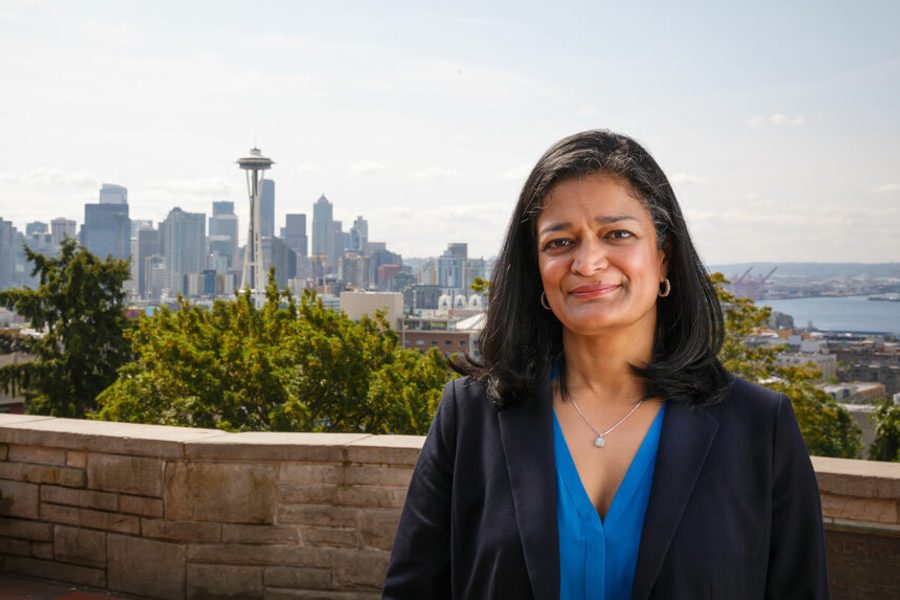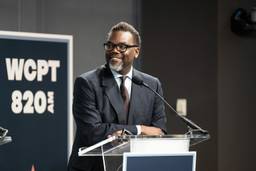Meet the Berniecrat On Her Way to the U.S. House After One of This Year’s Biggest Progressive Wins
Pramila Jayapal was one of the first down-ballot candidates to receive Bernie Sanders’ endorsement—and now she’s advancing to the November election, where she’s expected to easily win the heavily Democratic district.
Rachelle Hampton

Pramila Jayapal scored one of the biggest progressive victories of 2016, winning the Democratic primary for Washington’s liberal 7th District House seat with 38 percent of the vote, 17 points ahead of her nearest opponent. Jayapal also has the distinction of being one of the first down-ballot 2016 candidates to receive Bernie Sanders’ endorsement. On the eve of her August 2 primary, Sanders said, “When you think of the political revolution, I want you to think about Pramila.”
Now she’s advancing to the November election, where she’s expected to easily win the heavily Democratic district.
Born in 1965 in Chennai, India, Jayapal came to the United States at 16 to study at Georgetown, going on to earn an MBA from Northwestern. She emerged onto the Seattle political scene in the aftermath of 9/11, founding a group to battle discrimination against Arab, Muslim and South Asian communities. It would evolve into the largest immigrant advocacy organization in Washington State. As a state senator, Jayapal sponsored legislation to raise the minimum wage — a bill also up for a vote in the November election — and introduced the Washington Promise Scholarship Program, which would provide students with financial needs and top grades two free years of community college.
In These Times caught up with Jayapal by phone in late August to discuss what’s at stake with a Trump presidency — and what it would mean to be a U.S. Representative with the power of a movement behind her.
You won your primary by 17 percentage points in a three-way race. How?
My message is resonating with people: making this economy work for working families, taking government back from the wealthy. People want somebody who is accountable to regular folks and not to huge corporations.
It matters when you have a real base and a real knowledge of the communities you’re representing. That’s why we organizers need to be running for political office. The things I’m running on are things I’ve worked on my entire life: Social Security, single-payer healthcare, free college, the Fight for $15, racial justice, gender justice, environmental justice.
It’s also about how we’re running the campaign. It’s a movement campaign. We had 1,000 volunteers. We knocked on 70,000 doors. We made over 140,000 phone calls. We were talking to people. We were listening to what they have to say. I’ve always said, it’s not about electing me, it’s about electing “we.”
What are your takeaways from Bernie Sanders’ campaign?
People are ready for a political revolution. They want people of principle in power. They want to be part of the movement that helped implement that change. No single person, whether it’s Bernie Sanders or me or anybody, is going to be able to do this on their own. We need a bigger, stronger, broader movement. That’s what Bernie has shown us. A lot of people are thinking about running for office now, thinking of being engaged in the political process in a very different way.
You’ve sounded the alarm about a Trump presidency. What would you say to “Never Hillary” supporters?
It’s not about party unity. As an immigrant woman of color, I cannot afford to have Trump come close to the White House. We do tremendous damage to the country if Trump wins with 40 percent of the vote because a bunch of people stay out and vote for third party candidates. A lot is at stake.
A Trump presidency will require an enormous amount of defense to stop terrible things from happening. With a Clinton presidency, we will be on the offense. There will be times when we’ll have to be on the defense, but we will also be able to work with the White House to try to push our ideas forward.
Are there any Bernie supporters in Congress you hope to work with?
A lot. Many of the members of the Congressional Progressive Caucus: Keith Ellison, Raúl Grijalva, Zephyr Teachout, if she gets elected, Russ Feingold in the Senate. There’s a whole group of Bernie supporters I am very excited about working with.
What role do you think the Progressive Caucus should play — both in Congress and in the Democratic Party?
It needs to continue to put forward a progressive vision of America with specific action items and pieces of legislation. Sometimes, that comes in the form of “message” bills that the movement can organize around even if they won’t pass. And sometimes it’s budget provisos and other measures that fly very much under the radar but actually move things in the right direction. It’s going to have to be a combination of tactics, including working and talking with other people. Even if they’re not going to come on board for the whole agenda, they may come on board for a piece of it.
What progressive measures have a chance of passing under Clinton?
Immigration reform, a $15 minimum wage, policies around affordable childcare, paid sick leave and some tax reforms. Banning corporate inversions and instituting a financial transactions tax might be harder, but she has embraced them. Free college. Extending Medicare to a larger population. Healthcare has been a critical issue for her, and I do think she is on board to look at an option that gets us closer to single-payer.
Some say Trump’s rise signals a divide between white men and other Americans. Would you address that as a member of Congress?
A lot of layers are involved. White men are concerned with their economic future, and my platform is about addressing the scarcity that people are feeling: that they’re one health crisis away from bankruptcy, or can’t afford to send their kids to college, or can’t earn a living wage that allows them to buy a home or put food on the table. Those are real issues — not just for white men but across the board. So there’s a place for white men in our movement going forward. We have to address this fear and scarcity on an economic level, and then maybe we can get at some of the other pieces of the fear on a racial level as well.
How do you plan to address systematic racial injustice?
The criminal justice system is one obvious way. But even within the criminal justice system, it isn’t just getting rid of the private prison industrial complex, and it’s not just getting rid of the felony misdemeanor category. It’s also about legal representation. Look at the public defense system: It’s so broken. The jury system: It’s so broken. The prosecutorial system: It’s so broken. There’s still no representation.
Education is another huge bucket. I’ve spent a lot of time working on the opportunity gap — getting rid of suspensions and finding alternative ways to manage challenges in the classroom so that you don’t have African-American kids getting suspended when they’re 2.
Wealth and inequality are another piece. An Institute of Policy Studies report says the average black family would need 228 years to get the wealth of the average white family. One of the report’s recommendations is to audit how federal policies lead to inequality. Many policies, like the mortgage tax deduction, allow the wealthy to get wealthier.
What about the gender inequality that’s part of wealth inequality?
It’s so huge. In the state Senate, I introduced a bill to put $5.25 million into pre-apprenticeship programs specifically for women and people of color, because unless you target investments at women and at people of color, you do not get rid of that inequity. There are entire industries that are primarily low-wage women of color. If we were to focus on lifting up the wages of those industries, we would actually dramatically affect the earning potential and the living conditions of women of color.
What is the most effective way to apply pressure, inside and outside Congress?
We need to develop some new structures that support inside-outside organizing. Right now, folks on the outside organize and come up with a strategy and then try to push the person on the inside. When you have a movement organizer on the inside, then you can actually create that structure where we’re planning together. Not that we do all of our planning together, but at least some of it is happening together. It’s very exciting to think about having a critical mass on the inside, and not just one person.







